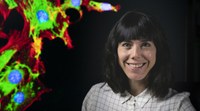A new research group will explore machine learning potential in genomics
Genetic processes dictate both healthy and disease-associated cell behavior. By analyzing how the more or less 20,000 known human genes are used across various conditions, researchers have the possibility to identify the indicators of a specific disease or the effects of a drug. To do so, scientists must analyze very large amounts of data — thousands of genes across many conditions. This is where artificial intelligence tools, such as machine learning or statistics, can provide a significant help. Coming from the Francis Crick Institute, dedicated to understanding the biology underlying health and disease, Raphaëlle Luisier started a new research group at Idiap to deepen the link between health and genomics thanks to informatics and math. We met her for an interview.
Are you a biologist or a computer engineer and what guided you into this field?
I’m a computational biologist. During my undergraduate studies in Bioengineering at EPFL, I quickly developed a strong interest for math as a tool to tackle biological problems. Since then I have been developing computational models and statistical methods for interpreting complex data-sets to address various biological questions related to human disorders. During my master project at the Queensland University of Technology in Australia, I developed mathematical models from imaging data to study how different cellular behavior can lead to specific tissue morphology. I then shifted my research focus during my PhD in Basel to study the internal cell processes underlying changes in cell behavior; in this project I developed statistical models to interpret the behavior of human genes at the early stage of liver cancer. Finally, in London at the Francis Crick Institute, I further studied the complex gene regulation in developing neural cells from patients suffering neurodegenerative disorders using RNA sequencing analysis (editor’s note: RNA, for Ribonucleic acid, plays an important role in coding and decoding genes). I was really lucky to collaborate with a renowned neuroscientist, Rickie Patani, who shared with me his very rich data, and Andrea Serio a specialist in neural tissue engineering.
What kind of application could result from such research?
I always keep patients’ needs as the goal of my research, even if it’s in the long term. For example, by analyzing cell cultures at regular intervals you can observe emerging properties linked with internal cell processes and identify the timing of disease development. Thanks to this you can develop better tools for an early diagnosis or you can observe the effects of a drug at various stages of the disease. This approach can reveal early biomarkers related to diseases that can help to identify relevant drugs for a specific treatment, especially for neurodegenerative diseases for which no treatment exists. Indeed, the collaboration with Rickie Patani at the Francis Crick Institute led to a breakthrough discovery of the earliest detectable molecular activity associated with amyotrophic lateral sclerosis (ALS), a rapidly progressive and fatal neurodegenerative disorder. This is a typical process that can be tackled for drug development. Beyond this fundamental research aspect, data mining can also be applied to other fields related to health. It can provide patients with useful insights to manage their health.
In which direction do you plan to continue your research at Idiap?
The Idiap female fellowship program was a great opportunity not only to come back to Switzerland, but also to boost my career by creating a brand new research group. Until now, I have been using cell population-level based imaging or genomic data. However fundamental biological processes including disease development occur at the single-cell level. So called time-lapse fluorescence live-cell imaging technique generates rich data that can be used to detect and track individual cell's changes, such as size, morphology, and movement in space and time. Combining cell imaging with genomic data through the collaboration with Patani and Serio laboratories will allow us to study how molecular biology shapes cellular morphology at an early stage of amyotrophic lateral sclerosis disease. As Idiap has a strong record in image processing and machine learning, the institute is a great place for me. The dedicated developers team and multidisciplinary groups are also an important asset. The mindset I found at Idiap was exactly the kind of spirit I was looking for: challenging, open-minded and collaborative. I look forward to bringing new skills in genomics and data visualization to Idiap, in order to create new and unexpected collaborations.
More information
- Raphaëlle Luisier personal webpage
- Genomics & health informatics group
- Francis Crick Institute
